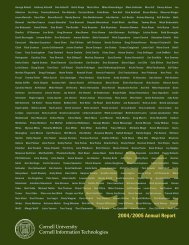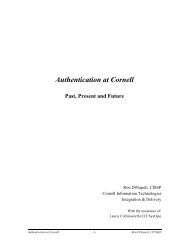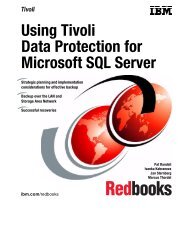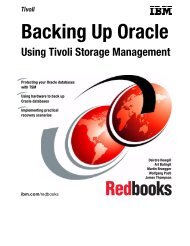Installation and User's Guide - Services and Support
Installation and User's Guide - Services and Support
Installation and User's Guide - Services and Support
Create successful ePaper yourself
Turn your PDF publications into a flip-book with our unique Google optimized e-Paper software.
IBM ConfidentialStorage Manager server (VSS Restore <strong>and</strong> longer term storage). It is recommendedthat different sets of policies be created for backups to both local shadow volumes<strong>and</strong> to Tivoli Storage Manager server storage. If you are using a VSS providerother than the Windows VSS System Provider, make sure to review thedocumentation for that specific VSS provider.VSS operations in DS <strong>and</strong> SAN Volume Controller environmentsIn order to determine how much storage space is required for each local backup,be aware that the backup LUNs require the same amount of storage space as theoriginal LUNs. For example, if you have a 100GB database residing on a 200GBLUN, you will need a 200GB LUN for each backup version.VSS limitations for SAN Volume Controller: When performing a Data Protectionfor Exchange VSS backup (non-offloaded) with backup destination as TivoliStorage Manager Server, <strong>and</strong> the Exchange Server data resides on SAN VolumeController (SVC) disks, <strong>and</strong> the IBM TotalStorage VSS Hardware Provider is beingused, in some isolated cases the SVC LUNs remain mapped to the Windows hosteven though the VSS backup is complete. To work around this issue, you can use abackup destination other than TSM (BOTH or LOCAL). You can also manuallyunmap the volumes attached to the Windows host to work around this issue.When performing two Data Protection for Exchange VSS backups, back to back,<strong>and</strong> the Exchange Server data resides on SAN Volume Controller (SVC) disks, ifthe volumes are large <strong>and</strong>/or the SVC background copy rate is set a low number,it may appear that the second VSS backup is hanging. In fact, it is waiting for theSVC background copy of the first backup to complete before proceeding with thesecond backup. SVC will not allow two background copies of the same volume tooccur at the same time. There is no indication that the second backup is waitingfor the first SVC background copy to complete. You may also see timeouts errors ifthe previous SVC background copy takes too long. To work around this issue,schedule your VSS backups far enough apart to accommodate this situation. Youcan also try increasing the copyrate of the SVC background copy.VSS operations in IBM N-series <strong>and</strong> NetApp environmentsBe aware that in environments that contain IBM N-series <strong>and</strong> NetApp systems,snapshots created using the IBM N-series <strong>and</strong> NetApp snapshot provider arestored on the same volume where the LUN resides. Disk space consumed by alocal backup consists only of the blocks that have changed since the last localbackup was created. The following formula can be used to help determine howmuch space is required for each local backup:Amount of data changed per hour * number of hours before a local backup expiresIn addition, Write Anywhere File Layout (WAFL) reserves blocks equal to twotimes the specified size of the LUN to be used. This space reservation ensureswrites for virtual disks. The following example demonstrates how to calculate thesize of these volumes:Database size of an Exchange storage group: 100GBNumber of local backups to be kept: 3Snapshot for TSM backup: 1duration for TSM backup: 2hrBackup frequency: 3hrsThe duration before a local backup is expired: 9 hrsAmount of data changed/added/deleted per hr: 50MBSpace required for each local backup: 50*9= 450 MBSpace required for 3 local backups + 1 TSM backup: 450*3 + 50*2 = 1450 MBThe volume size required for the storage group: 100*2 (space reservation) + 1.5 = 201.5 GBChapter 3. Configuring Data Protection for Exchange 33














